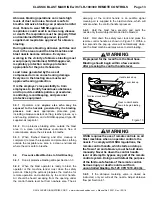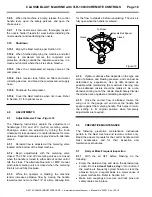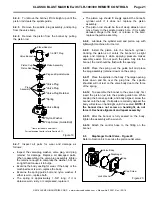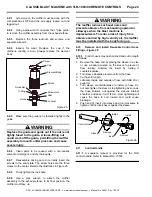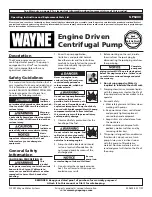
CLASSIC BLAST MACHINE with TLR-100/300 REMOTE CONTROLS
Page 15
© 2018 CLEMCO INDUSTRIES CORP.
www.clemcoindustries.com
Manual No. 22501, Rev. I 02/18
automatically drops when air is expelled from the
machine and pressure equalizes.
3.7.2
When the control handle lever is released, the
safety lever lock will flip up to lock the handle lever in the
up (no blast) position. Make sure the safety lever lock is
up to prevent the handle lever from engaging.
3.7.3
Always open the safety petcock during work
breaks and before filling the blast machine. Opening the
petcock prevents unintentional blasting.
3.7.4
When finished blasting, shutdown per Section
3.10.
3.8
Loading Abrasive into the Blast Machine
WARNING
When approaching an idle blast machine and
before loading the blast machine with
abrasive, always check to make sure the
safety petcock is open. If it is closed, open it
while standing back and facing away from the
concave head and exhaust muffler. This step
is especially important if a machine tender
loads the machine with abrasive while the
blast operator controls the blasting. The blast
operator could pressurize the machine before
the machine tender has moved away from the
machine. During pressurization, abrasive
could be forced out of the top of the machine
and cause injury.
WARNING
Obtain safety data sheets (SDS) for the blast
abrasive. Abrasive blasting with sands
containing crystalline (free) silica can lead to
serious or fatal respiratory disease. As NIOSH
recommends, do not use abrasives containing
more than trace amounts (more than one
percent) of free silica.
3.8.1
Load
abrasive
by pouring it into the concave
head. Use a screen (screen comes with blast machine
packages) placed over the filling head to prevent foreign
objects from falling inside. Foreign objects will jam the
machine. Abrasive
flows through the filling port into the
machine. Keep the abrasive level below the top of the
pop-up valve to prevent abrasive from being forced up
and out of the machine when it pressurizes.
3.8.2
When ready to blast, the operator or machine
tender, while standing back and facing away from the
concave filling head and exhaust muffler, closes the
safety petcock.
3.8.3
Begin blasting or resume blasting per Section 3.4.
3.9
Emptying the Machine of Abrasive
3.9.1
Empty the machine of all abrasive when shutting
down for the day. Condensation dampens abrasive and
causes flow problems. When working in environments
subject to extreme temperature changes or very humid
conditions, condensation may develop inside the
machine. Emptying the machine at the end of the workday
eliminates trouble caused from moist abrasive when
starting a new day's blasting. One way to avoid having to
empty the machine is to load only as much abrasive as
will be used during the work period. If the machine must
be purged of abrasive, do the following:
3.9.2
With the blast machine OFF, turn the blast
pressure to approximately 50 psi, close the choke valve,
and fully open the abrasive metering.
3.9.3
To prevent wear to the nozzle holder threads,
firmly attached the nozzle to the nozzle holder.
Removing the nozzle is not recommended. If
circumstances require the nozzle to be removed, also
remove the nozzle washer. Purging the machine without
a nozzle will eventually erode the thread area of the
nozzle holder. Thread wear could cause a hazardous
condition when the nozzle is reinstalled.
WARNING
The threads on the nozzle and nozzle holder
must be inspected each time the nozzle is
secured to the holder. A loose fitting nozzle may
eject under pressure and can cause severe
injury. Check the threads for wear and make sure
the nozzle holder securely holds the nozzle. The
nozzle washer must also be inspected for wear.
When nozzle washers are worn, abrasive could
erode nozzle threads.
3.9.4
Point the nozzle into a drum or suitable
container, or toward the direction where the abrasive is
to be disposed.
3.9.5
Hold the hose securely and pressurize the
machine by activating the control handle. Be prepared
for severe surging and recoil of the hose.













